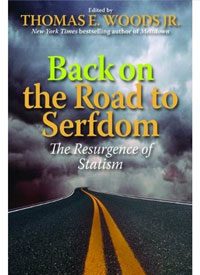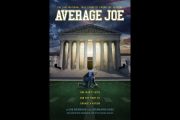
“The road is always better than the inn,” said the great Cervantes, who was no doubt wrong about other things as well. The road is not always better than the inn. The traveler who was robbed and beaten on the road to Jericho probably didn’t think so. Even absent the brigands, there are a lot of variables, including the condition of the road, the weather conditions, and, most importantly, where the road leads. There is, according to an authority greater than Cervantes, a broad way that leadeth to destruction and many travel it. There is also a road to salvation and, because it is narrow, few find it and fewer still take it.
The choice between the broad and narrow ways has its parallel in social and economic policy, as Back on the Road to Serfdom, edited by Thomas Woods, indicates. The title and theme of the book are based on the classic The Road to Serfdom by Nobel laureate F.A. Hayek. Hayek’s book, published in 1944 and republished many times since, is something of a cult classic among economic conservatives, who are the liberals of yesteryear. Indeed, Hayek, an Austrian economist who emigrated to England, considered himself a liberal. His Road to Serfdom, while still worth reading, could use a little updating since, as Woods notes in his introduction, the totally collectivist, Marxist state against which Hayek inveighed in the 1940s is no longer the utopian ideal. But even though Soviet communism may be discredited, illusions about the benefits of a planned economy have survived through various mutations. They are a matter of faith to the intellectual descendants of the Fabian Socialists and New Deal Democrats, and chances are good that such devout believers in the beneficence of the State won’t easily be persuaded by statistical evidence. As the Objectivist philosopher Ayn Rand noted decades ago, in a mixed economy, capitalism invariably gets blamed for the failures of socialism.
Thus, the burst of the artificially created housing bubble and the overall collapse of the financial industry in 2008 is generally blamed on a right-wing zeal for deregulation. We simply did not have enough government bureaucrats with the public interest at heart overseeing and reining in the excesses of the cold, cruel market forces. Never mind that the government-created Fannie Mae and Freddie Mac — which agencies banks confidently and accurately expected would buy up their many shaky low-doc, no-doc, and “liar” loans — were not built by Adam Smith’s invisible hand. Never mind that by the year 2000, Andrew Cuomo, now the Governor of New York, but then the nation’s Secretary of Housing and Urban Development, was boasting of how his agency had “persuaded” banks to issue tens of millions in home mortgages to customers they would otherwise have turned away as poor credit risks. The political result of the 2008 collapse is a revival of enthusiasm for government regulation, some 10 to 15 years after President Bill Clinton declared in a State of the Union Address: “The era of big government is over.”
Clinton didn’t mean that, and most of the members of Congress who applauded that line with such apparent enthusiasm didn’t want that and still don’t. Republicans, as much and possibly more than Democrats, love big government, their rhetoric to the contrary notwithstanding. We had a Republican Congress from 1995-2006 and big government got bigger and bigger — and bigger, especially after 2000, when the Republican Congress could hitch its wagon to a Republican White House. Then the spending jumped, like the cow in the nursery rhyme, over the moon.
Republicans and Democrats in Congress are fond of cows over the moon if they bring, by their much leaping, more federal dollars coming to the members’ states and districts. And nearly every advance in statism seems irreversible, which is why Congressman Ron Paul seems so eccentric for wanting to rein in, if he can’t eliminate, the money-manipulating Federal Reserve Board. Chances are excellent that most Americans today are unaware that the country was doing fine for its first 125 years under the Constitution before the “Fed” was created. Those troubling cycles of “boom and bust” were fewer and further between and recessions were of shorter duration in the bad old days before the Fed was there to keep things under control. Yet our educational system is designed to instill in the minds of young citizens and future voters the belief that our society would likely fall off the Earth and go spinning out into space if the federal government and its myriad regulating agencies were not alternately putting the government’s foot on the accelerator and the brake to keep our economic engine under control.
That is why reading the essays in this book, or nearly anything else that Thomas Woods has published, is like entering an alternate universe. Our minds are so used to accepting the distortions that the reality looks like heresy. And why should it be otherwise? Why should those who control the apparatus of government want schools that educate people to think for themselves? They might come to conclusions that are dangerous — for the government. It is imperative to keep the inquiring minds that have not been too anesthetized by dumbed-down texts and dumber exams to think at all, thinking inside the proverbial box.
The ideas in Back on the Road to Serfdom have the power to bring America back to something like what the Founders envisioned. But the greatest sin to the “progressive” mind is to propose that we “turn back the clock.” The “clock” is the only thing the collectivists seem to regard as self-regulating — as long as the hands keep moving toward further state control. So none but the most discouraging words about the “Robber Barons” who were the captains of American industry in the latter third of the 19th century are likely to be heard in the typical American classroom.
What might wake some students up long enough to think a little bit is a statement like this one from the book’s opening essay, “Economic Policy and the Road to Serfdom: The Watershed of 1913” by Brian Domitrovic: “The most impressive half century in American — arguably world — economic history was that which followed the Civil War: the nearly fifty years from 1865 to 1913. The American economy expanded at a yearly rate of 3.62 percent per year” during that period, Domitrovic wrote. “By way of comparison, from 1913 to 2008, (also a peak-to-peak period), the American economy grew at 3.26 percent. The difference of about four-tenths of a percent per year proved enormous. Had the United States preserved the trend that held in the half century after the Civil War, it would now be half again richer than it is now, in the second decade of the twenty-first century.”
Is it merely coincidence that the pivotal year in that comparison is 1913, the year the Federal Reserve Act, creating the Federal Reserve Board, was enacted, a milestone of the “Progressive era”? It was also the year the income tax was established and made permanent. That is, the tax was permanent; the rates were upwardly mobile. You might even call it upward mobility on steroids.
“As for income taxes,” wrote Domitrovic, “The first top rate, upon passage of the 16th Amendment in 1913, was 7 percent. In four years’ time, it was up elevenfold, to 77 percent. Meanwhile, someone whose income merely kept up with the inflation engineered by the Fed — that is someone who saw no actual gain in income — could be pushed into the stratospheric top bracket, since the progressive top brackets were not adjusted for inflation…. The investor class soon adjusted away from entrepreneurship and into tax shelters.” The Federal Reserve and the income tax had distorted the economy and discouraged investment. But, saints be praised, both came along in time to finance, with heavily taxed and inflated dollars, America’s entry into World War I, the war to end wars and make the world safe for … well, safe for more wars, of course, and eventually a hyperactive national government.
A coincidence, perhaps? Well, Domitrovic is less dogmatic than his critics might be. He concedes that correlation is not causation. “Perhaps fiscal and monetary policy had nothing to do with the sub-Gilded Age performance of the economy since 1913. Perhaps their absence had nothing to do with the impressiveness of economic performance before then.” But, he noted, “The correlation is fact. Every period of sustained peak economic activity in the United States since 1865 has correlated to the nonexistence, or the blanket retreat, of fiscal and monetary policy.”
There is much more in this slender, but highly informative volume that can work wonders in changing the way we look at government and economic growth. It is difficult to touch on any of the essays in a brief review like this, for fear of giving them short shrift. But it is at least worth noting that there are equally, if not more, important social consequences to the economic malpractice of government engineers. One of the amazing accomplishments of the American economy is that it has been able to absorb the influx into the workforce of the two-income family, without devastatingly high unemployment. At the same time, the double whammy of inflation and taxation has made two incomes a necessity for many, if not most, families. And there are social consequences to that in the wear and tear on the family structure and in the all-important bonding between mother and child. In only one of several important points made by Per Bylund in “The Modern Welfare State,” a study of Sweden as the paradigm of the nation-state as benevolent provider, the author notes: “This generation is now the demanding parents of young children, who are also brought up primarily in public day-care centers and in public schools, and they — as parents — often claim that the state has to take ‘responsibility’ for their children so they can have time for self-fulfillment.”
It is a long journey, in time and in ideology, from “the pursuit of happiness” proclaimed as a natural right in the Declaration of Independence to the “self-fulfillment” demanded as an entitlement in the modern welfare state. And one of the consequences may be summed up in the words of One who wanted the children to come to Him, but did not demand a government program to bring them.
“Suffer the little children… ”
Back on the Road to Serfdom: The Resurgence of Statism, edited by Thomas E. Woods, Jr., Wilmington, Delaware: ISI Books, 2010, 234 pages, hardcover.



